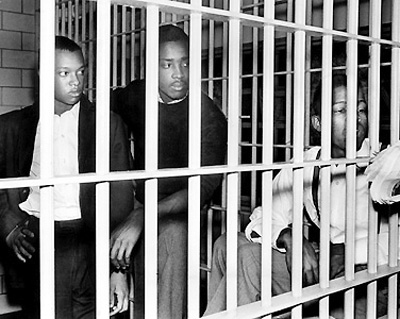John Lewis
February 21, 1940 – July 17, 2020
Raised near Troy, Alabama

John Lewis, O.D. Hunt, and Dennis Gregory Foote arrested during the Nashville Student Movement, undated, crmvet.org
Every Tuesday night for the fall semester of 1959, John Lewis made his way to Clark Memorial United Methodist Church in Nashville, Tennessee. There, in the church basement, Rev. James Lawson mentored a group of Black college students in the philosophy and tactics of nonviolent direct action. “Those Tuesday nights became the focus of my life,” recalled Lewis, who’d since childhood in rural Alabama sought a way to fight white supremacy.
Lewis was raised on a small farm in Troy, Alabama, about fifty miles south of Montgomery. Early on, he grew resentful, not only of the visible signs of Jim Crow, but also of the exploitative economic relationship between his family and the white landowners. As sharecroppers, his family barely scraped by planting and harvesting cotton. It seemed to him that they were working hard for nothing. “As soon as I was able to make sense of the world, I could see there was no way a person could get ahead as a tenant farmer,” he explained.
As a freshman at the American Baptist Theological Seminary in Nashville in 1957, he tried to form a campus chapter of the NAACP, but the school shot the idea down. Like many Black colleges, American Baptist relied on white funding and didn’t want the risk of getting involved in the Movement. But Lewis persisted. One evening, he heard James Lawson discuss the philosophy and tactics of nonviolence, and to Lewis, it felt like “it was something I’d been searching for my whole life.”
Lawson’s workshops in the basement of Clark Memorial were the foundation of the Nashville Student Movement. Black students from Fisk University, American Baptist, and other local colleges discussed and debated the principles of nonviolence. They studied the history of nonviolent struggle and even engaged in role-playing exercises. In October 1959, the young people formed the Nashville Student Movement, and on February 13, 1960–less than two weeks after the Greensboro sit-ins–the group initiated its own sit-ins in downtown Nashville.
In 1961, Lewis became one of the original freedom riders and was badly beaten. In 1963, he became SNCC’s chairman. Representing SNCC at the March on Washington he criticized the Kennedy administration for failing to protect the constitutional rights of Black Americans. With the help of Courtland Cox, James Forman, Nancy Stern, and others, who drafted his speech, he charged that the Kennedy’s proposed civil rights bill offered “too little to late.” As the march began, however, some of its other participants objected to Lewis’s language and threatened to withdraw. Out of respect for A. Phillip Randolph, SNCC revised the speech at the last minute.
Nonetheless, “I felt defiance in every direction: against the entrenched segregation of the South; against the neglect of the federal government; and also against the conservative concerns of the established factions,” Lewis recalled.

John Lewis speaks from the steps of the Lincoln Memorial at the March on Washington, August 1963, Danny Lyon, Memories of the Southern Civil Rights Movement 82, dektol.wordpress.com
In 1965, Lewis was active at the height of the Selma voting rights campaign–a campaign SNCC had begun two years earlier. On Sunday, March 7, 1965, the marchers were viciously attacked by state troopers and sheriff Jim Clark’s mounted posse. Lewis received a concussion and fractured skull. Despite the injuries he received on Bloody Sunday, Lewis took part in the Selma-to-Montgomery march two weeks later.
Though he was subjected to incredible violence and numerous arrests during his activist career, Lewis remained committed to philosophical nonviolence.
Lewis served as SNCC’s chairman until he was replaced by Stokely Carmichael in May 1966. Many in SNCC felt that Lewis’s commitment to nonviolent direct action and mass protests was out of sync with SNCC’s turn away from such actions. Shortly after, he left the organization to pursue a long career in electoral politics–serving as a congressman from Georgia’s 5th congressional district for almost 30 years.
Sources
Charles E. Cobb, Jr., This Nonviolent Stuff’ll Get You Killed: How Guns Made the Civil Rights Movement (Durham, NC: Duke University Press, 2016).
James Forman, The Making of Black Revolutionaries (Seattle: University of Washington Press, 1985).
John Lewis with Michael D’Orso, Walking with the Wind: A Memoir of the Movement (New York: Simon & Schuster, 1998).
Interview with John Lewis by Blackside, Inc., May 14, 1979, Eyes on the Prize, Henry Hampton Collection, Washington University.
Interview with John Lewis by Jack Bass and Walter Devries, November 20, 1973, Southern Oral History Program, University of North Carolina.
SNCC’s Speech from the March on Washington, August 28, 1963, Civil Rights Movement Veterans Website.




